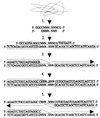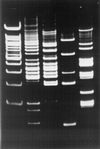Differentiation of pathogenic Bartonella species by infrequent restriction site PCR
- PMID: 10921969
- PMCID: PMC87173
- DOI: 10.1128/JCM.38.8.3010-3015.2000
Differentiation of pathogenic Bartonella species by infrequent restriction site PCR
Abstract
Infrequent restriction site PCR (IRS-PCR) is a recently described DNA fingerprinting technique based on selective amplification of restriction endonuclease-cleaved fragments. Bartonella isolates associated with human disease and related nonhuman isolates were analyzed by IRS-PCR genomic fingerprinting. Preparation of DNA templates began with double digestion using three different restriction endonuclease combinations. Combinations included the frequently cutting endonuclease HhaI in conjunction with an infrequently cutting endonuclease, EagI, SmaI, or XbaI. Digestion was followed by ligation of oligonucleotide adapters designed with ends complementary to the restriction endonuclease sites. Amplification of fragments flanked with an EagI, SmaI, or XbaI site in combination with an HhaI site produced a series of different-sized amplicons resolvable into patterns by polyacrylamide gel electrophoresis (PAGE). The pattern complexity was varied by the addition of selective nucleotides to the 3' ends of the EagI-, SmaI-, or XbaI-specific primers. Amplicons were also generated with fluorescently labeled primers and were subsequently resolved and detected by capillary electrophoresis. Analysis by traditional slab PAGE and capillary electrophoresis provided suitable resolution of patterns produced with the enzyme combinations EagI-HhaI and SmaI-HhaI. However, the combination of XbaI-HhaI produced too many fragments for sufficient resolution by traditional PAGE, thus requiring the better resolving properties of capillary electrophoresis. Due to the flexibility in modulating the pattern complexity and electrophoresis methods, these techniques allow for a high level of experimental optimization. The results provide evidence of the discriminatory power, ease of use, and flexibility of the IRS-PCR method as it applies to the identification of human-pathogenic Bartonella species.
Figures





Similar articles
-
Inter- and intraspecies identification of Bartonella (Rochalimaea) species.J Clin Microbiol. 1995 Jun;33(6):1573-9. doi: 10.1128/jcm.33.6.1573-1579.1995. J Clin Microbiol. 1995. PMID: 7650189 Free PMC article.
-
Genomic fingerprinting of Bartonella species by repetitive element PCR for distinguishing species and isolates.J Clin Microbiol. 1995 May;33(5):1089-93. doi: 10.1128/jcm.33.5.1089-1093.1995. J Clin Microbiol. 1995. PMID: 7615711 Free PMC article.
-
Identification of Bartonella species directly in clinical specimens by PCR-restriction fragment length polymorphism analysis of a 16S rRNA gene fragment.J Clin Microbiol. 1999 Dec;37(12):4045-7. doi: 10.1128/JCM.37.12.4045-4047.1999. J Clin Microbiol. 1999. PMID: 10565929 Free PMC article.
-
Differentiation of Bartonella species using restriction endonuclease analysis of PCR-amplified 16S rRNA genes.FEMS Microbiol Lett. 1995 Jun 15;129(2-3):261-5. doi: 10.1111/j.1574-6968.1995.tb07590.x. FEMS Microbiol Lett. 1995. PMID: 7541758
-
Molecular investigation of two clusters of hospital-acquired bacteraemia caused by multi-resistant Klebsiella pneumoniae using pulsed-field gel electrophoresis and in frequent restriction site PCR. Infection Control Group.J Hosp Infect. 2000 Oct;46(2):110-7. doi: 10.1053/jhin.2000.0815. J Hosp Infect. 2000. PMID: 11049703
Cited by
-
Multispacer typing to study the genotypic distribution of Bartonella henselae populations.J Clin Microbiol. 2006 Jul;44(7):2499-506. doi: 10.1128/JCM.00498-06. J Clin Microbiol. 2006. PMID: 16825371 Free PMC article.
-
Limited diversity among human isolates of Bartonella henselae.J Clin Microbiol. 2002 Dec;40(12):4691-9. doi: 10.1128/JCM.40.12.4691-4699.2002. J Clin Microbiol. 2002. PMID: 12454174 Free PMC article.
-
Arbobacteria - Pathogens Transmittable by Arthropods.Transfus Med Hemother. 2008;35(5):374-390. doi: 10.1159/000112812. Epub 2008 Sep 26. Transfus Med Hemother. 2008. PMID: 21512627 Free PMC article. No abstract available.
-
Arbobacteria - Pathogens Transmittable by Arthropods.Transfus Med Hemother. 2009;36(1):62-78. doi: 10.1159/000197341. Transfus Med Hemother. 2009. PMID: 21048822 Free PMC article. No abstract available.
-
Identification of Bartonella bacilliformis genotypes and their relevance to epidemiological investigations of human bartonellosis.J Clin Microbiol. 2002 Oct;40(10):3606-12. doi: 10.1128/JCM.40.10.3606-3612.2002. J Clin Microbiol. 2002. PMID: 12354853 Free PMC article.
References
-
- Aarts H J, Hakemulder L E, Van Hoef A M. Genomic typing of Listeria monocytogenes strains by automated laser fluorescence analysis of amplified fragment length polymorphism fingerprint patterns. Int J Food Microbiol. 1999;49:95–102. - PubMed
-
- Armengol C E, Hendley J O. Cat-scratch disease encephalopathy: a cause of status epilepticus in school-aged children. J Pediatr. 1999;134:635–638. - PubMed
-
- Arnold C, Metherell L, Clewley J P, Stanley J. Predictive modelling of fluorescent AFLP: a new approach to the molecular epidemiology of E. coli. Res Microbiol. 1999;150:33–44. - PubMed
-
- Bass J W, Vincent J M, Person D A. The expanding spectrum of Bartonella infections. I. Bartonellosis and trench fever. Pediatr Infect Dis J. 1997;16:2–10. - PubMed
-
- Bass J W, Vincent J M, Person D A. The expanding spectrum of Bartonella infections. II. Cat-scratch disease. Pediatr Infect Dis J. 1997;16:163–179. - PubMed
MeSH terms
Substances
LinkOut - more resources
Full Text Sources
Molecular Biology Databases

